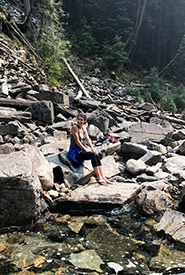Nature Destinations for a nation
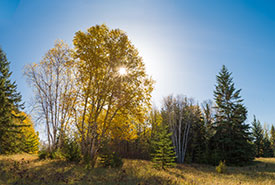
Bunchberry Meadows Conservation Area, AB (Photo by Kyle Marquardt)
As a former Nature Conservancy of Canada (NCC) intern, avid nature lover and geography student, I’ve always found any kind of natural space a place worth visiting.
When I first discovered NCC’s Nature Destinations program, I thought it was a fantastic idea! Combining conservation with public recreation can bring more attention to biodiversity issues and local conservation efforts, as well as encourage people to connect with nature. After all, nothing brings awareness and appreciation like hands-on learning! So, what exactly is it that sets apart NCC’s Nature Destinations from other NCC properties?
Throughout my internship, I visited NCC’s Bunchberry Meadows property — a prime Nature Destination in Alberta — for a Conservation Volunteers event. Greeted by a gravel parking lot, educational signs, picnic tables and clean public restrooms on the property, I was pleasantly surprised by the extent of these people-forward amenities.
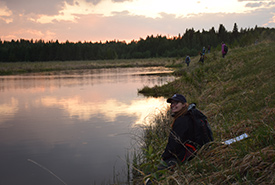
Hannah Schaepsmeyer, Conservation Volunteers program manager for NCC's Alberta Region, at Bunchberry Meadows Conservation Volunteers event (Photo by NCC)
Following the winding, eight-kilometre trail system, I strolled through an active wetland restoration site and stands of paper birch trees. I also saw an abundance of wildflowers and mushrooms. As soon as we wrapped up our Conservation Volunteers event, I immediately started planning my next visit. The diversity of landscapes, ecological features and visitor-friendly options were absolutely worth the nearly three-hour drive from my hometown of Cochrane, Alberta. The property is also only about 30 kilometres from the Edmonton city centre.
Related blog posts
Reflecting back on my adventures at Bunchberry Meadows and how they impacted me, I can only imagine the kinds of experiences field interns have, exploring troves of Nature Destinations throughout the summer. So, I reached out to a few fellow interns to try and get a better idea of what their time at NCC’s Nature Destinations meant to them.
In NCC’s Ontario Region, former interns Chelsea Marcantonio and Nicholas Armstrong are no strangers to Nature Destinations. Chelsea, who worked on the Hazel Bird Nature Reserve, appreciates the accessibility and biodiversity of these sites. With more opportunities for the public to spot some of Canada’s unique and rare species, she believes that “these little discoveries and connections are what make a person care for the environment as a whole system.”
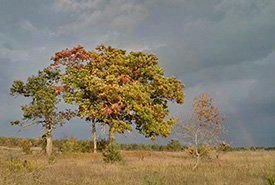
Hazel Bird Nature Reserve, ON (Photo by Mark Stabb/NCC staff)
Nicholas, who worked on the Backus Woods site, has a deep appreciation for the old-growth Carolinian forests on the property. According to Nicholas, these kinds of woods are shining examples of nature’s resilience in what “younger forests on other properties can become after restoration efforts.” Nicholas feels his efforts were most impactful when he cleared trails to prevent the disruption of sensitive species, while Chelsea notes that sharing stories and interacting with local communities kept her optimistic about the future state of the world.
Meanwhile, in Alberta, former interns Leanne Mitchell and Alejandra Guerrero have accumulated some great memories while working on Nature Destinations. In July, the two helped lead a Conservation Volunteers event at the Hopkins property, clearing trails and chatting up a storm at a community barbeque. The event was a huge success, providing Leanne with “a great opportunity to engage residents…and enjoy the stunning view of Coyote Lake.” Alejandra also points out how great Nature Destinations amenities can be, with so many “people coming out to enjoy trail systems, eat lunch with their families, do some birding, etc.” and not worry about getting lost, with all the signs and trail markers around.
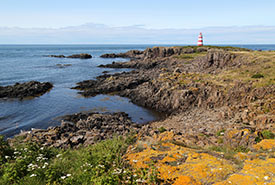
Brier Island, NS (Photo by NCC)
If given the chance, Alejandra would love to visit the Brier Island Nature Reserve in Digby, Nova Scotia. She’s intrigued by the whale-viewing opportunities, abundance and diversity of birds and the rather adventurous double ferry trip to get there! Leanne, however, would rather visit one of NCC’s newer Nature Destinations: Big Trout Bay in Neebing, Ontario. As a native Greater Toronto Area gal, she’s never been that far north or even visited Lake Superior before. If she ever does get to visit, though, Leanne can look forward to lakeside forests and wetlands, ragged cliffs, cobble beaches and 21 kilometres of trails.
Boasting unique ecological features, amenities and scenic views, it’s no wonder these Nature Destinations are so popular. From the 200-year-old forests of Boisé-Papineau Nature Reserve in Quebec and the native wildflowers and tall grass prairies of the Gainsborough Creek Trail in Manitoba, to the towering coastal Douglas-fir forests of BC’s Chase Woods Nature Preserve, these remarkable Canadian landscapes offer no shortage of new adventures for the wandering explorer. So, what do you say? Grab those hiking boots, rev up that curious spirit and get to know some of NCC’s proudest conservation projects, coast to coast.
The Conservation Internship Program is funded in part by the Government of Canada's Summer Work Experience program.

